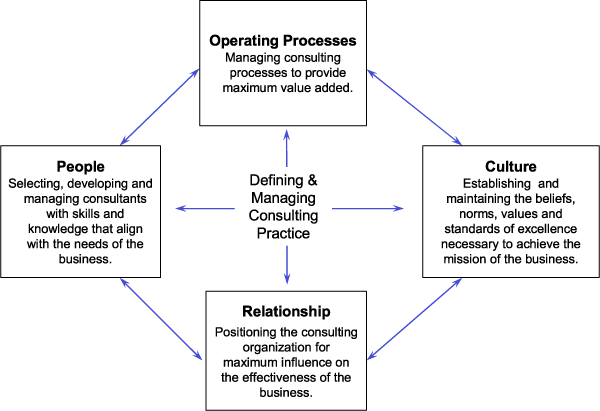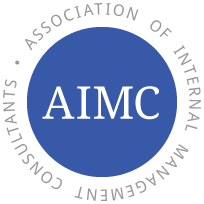Model of Internal Consulting

Element 1
- Relationship Management Business Development
- Determining the most needed services within the company
- Monitoring fit into organization (including reporting relationship)
- Clarity of marketing
- Leaders as teachers (building a role for leaders)
- Partnering with clients
- Build single image
- Core brand message
- Know client’s business
- Big consultants make this a core practice
- Ensure projects are strategic and fit with business plan – including risk assessment, prioritization and
- emerging projects
- Enhancing Relationships
- Positioning effectively with client organizations
- Access & credibility
- Communications & consistency of approach
- Establishing & maintaining effective networks of influence
- Formal & informal
- Alliances
- Centralized or distributed throughout the company
- Attaining/maintaining appropriate level of independence, allowing neutrality/objectivity
- Importance of critical relationships
- Know power dynamics of the organization
- Perform needs assessment of client
- Build trust and credibility (Trust Model)
- Expand role of managing external consultants/outsourced services
- Need to identify core relationships
- View relationship building as core product
- Relationships building is very time consuming and time must be built in for it
- Managing people above you in IC Organization to work on key relationships
- Elaborate on alliances (if we have formal contracts with our clients, need to be sure that this does not
- limit our ability to help them with all of their needs?)
- Maintaining Relationships
- Maintaining responsiveness to clients
- Ensuring client continuity
- Manage relationship impact of shifting resources to other projects
- Managing expectations
- Monitoring client satisfaction measures
- Delivering as promised
- Be aware of being a “second resource”
- Pay attention to relationship management with team members
- Management of self/ICs to model important behaviors
- Consider best practices, including managing self, building relationships, self awareness
- Tell client, at the beginning of assignment, how we measure our performance
- Embed learning and agility/receptivity into relationships
- Structure a formalized relationship management process
- Need to maintain visibility
- Touch points
- Contact points
- Use informal moments
Element 2
- Operating Processes
- Direction Setting:
- Defining the ICG business model and value proposition
- Developing processes for selecting the “right work” & contracting it for success
- Understanding capability and competency requirements
- Structuring an on-going benchmarking process
- Capacity Management:
- Formulating resource matching (supply/demand) and management processes
- Leveraging all (internal & external) resources to serve clients
- Developing/maintaining the “make/buy” decision-making process
- Managing suppliers and peer groups to help leverage service or expenses
- Capability Management:
- Standardizing & constantly improving methods of project planning, management, implementation and
- evaluation
- Developing and maintaining individual practice areas
- Maintaining a process for managing the collective knowledge/wisdom and information for the ICG
- Building in a continuous feedback and improvement capability
- Delivery Management:
- Managing engagements and on-going relationships proactively
- Increasing/optimizing productivity
- Coordinating, contracting and technology transfer from external projects
- IC Organization & Individual Consulting*
- Establishing accountability and continuity for value added
- Effectively measuring performance and business model/value proposition
- Importance of clarity of contracting to achieve business value
- Contracting includes: Framing; Definition of Success; Scope of work; Expectations; and Evaluation
- Process
* This category of process applies to both the Internal Consulting (IC) organization, and any individual
project assignment of your IC Group. It is particularly useful to manage the other process categories in
this Element (Direction Setting; Capacity; Capability and Delivery Management).
Element 3
- Culture
- ICG Mission/Values
- Operating from a well-defined standard of values
- Developing & maintaining practices that reinforce mission & values
- Supporting balance between independence of consulting staff & sense of
- communication & belonging
- Values, integrity, trust – not too enculturated into overall organization
- Bring your behavior (model desired behavior) – lead by example
- Create a collaborative culture
- Understand your values – explicit agreements
- Build trust/credibility in the organization
- ICG Performance
- Sustaining a high-level of performance
- Start engagement slowly to uncover problems
- Resist quick solution
- Do the post mortem after projects – feedback for improvement
- Behaviors must link to Scorecard
- Focus on sustainable change – measure to demonstrate sustainability
- Foster a high level of performance – supported by 360 degree feedback
- Engage clients in problem solving – partnering
- ICG Development
- Emphasize every consultant’s role in business development
- Including emphasis on repeat/follow-on business
- Supporting continuous learning
- Promote a culture of innovation
- Support continuous learning
- Build adaptability/accountability – contractual framework
- Enhance ability to embrace/drive change
- Build flexibility – adapt to different needs/situations
Element 4
- People
- Staffing
- Identifying skills practice areas require
- Acquiring solid skills
- Must manage expectations
- Establishing a strategy for attracting consultants
- Resource Management
- Managing morale & employee satisfaction
- Conduct continual observational research on ICG performance
- Consult in the context of client’s situation/needs
- Emphasize knowledge of the subject matter
- Develop process consultation as a core competence
- Create a willingness to share knowledge – willingness + a mechanism (two-way)
- Build ability to adapt to diverse ways/practices
- Manage constraints
- Development – Individual
- Emphasizing individual skills development programs
- Developing people for current & future needs
- Emphasize self-development as a priority (assessing your own ignorance)
- Managing variable resource model
- Develop and retain high potential people – IC as launching pad
- Development – Organizational
- Transferring skills, knowledge & practices of Internal Consulting Group to client gaps to enhance value to
- the enterprise
- Ability to deal with pressure
- Listening to build long term relationships
- Ability to facilitate well
- Work with resources from client – linking-pin role
- Partner with HR
